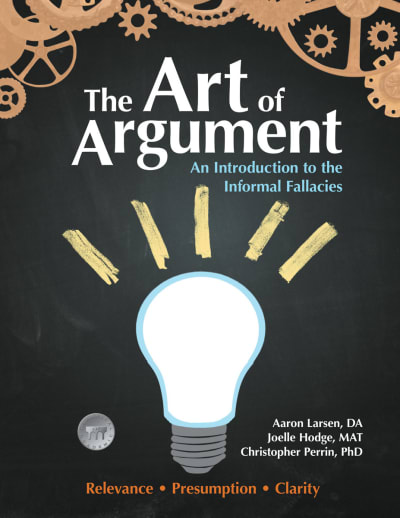Logic studies often start with a focus on incorrect reasoning. This text takes students through 28 fallacies organized by type: relevance, presumption, and clarity. Strewn throughout the text are full-color advertisements that help practice evaluating arguments. The end of the book includes 4 appendixes and a glossary of terms. Two appendixes provide creative options for applying fallacies: (A) a theatrical play demonstrating common fallacies (enter some cute high-school humor. What to expect with a title, “Bill and Ted’s Excellent Election”) and (B) Love is a Fallacy, a first-person creative writing by Max Shulman (©1951). Appendix C provides succinct yet thorough definitions of all fallacies, organized by type and a fallacy tree as a visual organizer. Appendix D provides a taxonomic “Table of You!” Consumable, 282 pgs, pb. ~ Ruth
Art of Argument Revised Edition Student Edition
Description
To mark the 20th anniversary of our best-selling informal logic text, The Art of Argument, we are releasing a new, revised edition that includes fresh examples, enhanced explanations, and a refreshed design. All of the best features of the award-winning first edition are preserved, and we have incorporated more comprehensive instruction about how to detect and avoid each of the 28 fallacies covered in the book. Updated fallacy examples for today's students and several new dialogues with everyone's favorite philosopher, Socrates, have been added as well. This edition also includes taxonomic fallacy trees to give students and teachers helpful visual guides as they seek to understand the commonalities and differences between the fallacies. Additional explanations and examples have been provided in the teacher's edition to better equip instructors to guide their students through the most challenging fallacy identifications.
One of the most important additions in this revision is a more explicit call for students and teachers to be truth seekers who approach debate, disagreement, and argument from a point of humility by seeking what is true without being distracted by the desire to be right. We have provided opportunities for students to practice the virtue of prudence as they build the tools necessary to learn how to reason well.
The newly revised Art of Argument is a richer, fuller, more naturally flowing text that fosters wonder, delight, and virtue as students learn to detect fallacious arguments in their own academic work, in the arguments of others, and in modern culture.
Socrates is the "go to" person when it comes to fallacies (occurrence of bad or incorrect reasoning) and his perspective on the three basic categories - fallacies of irrelevance (points that don't relate to the issue), of presumption (assumptions that are not justified or necessary), and of clarity (language that confuses and muddies) - is sought via time-travel. Several examples of each are provided plus the student has the opportunity to identify fallacies in cleverly fabricated magazine advertisements. Fallacies are printed on the inside covers of the Student Text for easy reference. Both Student and TE (each about 230 pgs, pb) have appendices that include a play and a short story that illustrate fallacies as well as a Glossary and Bibliography. TE includes reproducible chapter, unit, and final exams (with answer key). DVDs include 28 sessions (one for each fallacy) in which three teachers and 4 students present, define, discuss and explain the fallacy. As in the text, the DVDs emphasize a practical application to the student's life through advertisements, political speeches, and various moral/ethical debates.
| Product Format: | Paperback |
|---|---|
| Grades: | 7-12 |
| Brand: | Classical Academic Press |
| ISBN: | 9781600514500 |
| Length in Inches: | 11 |
| Width in Inches: | 8.5 |
| Height in Inches: | 0.75 |
| Weight in Pounds: | 1.8437 |

